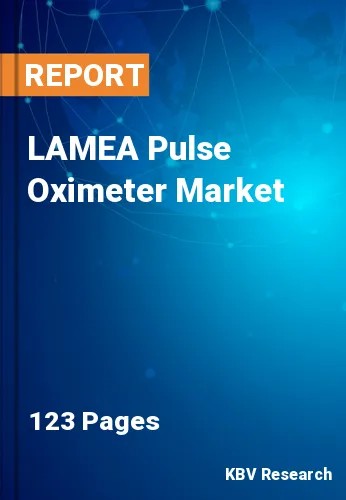The Latin America, Middle East and Africa Pulse Oximeter Market would witness market growth of 8.7% CAGR during the forecast period (2023-2030). In the year 2026, the LAMEA market's volume is expected to surge to 1,490.8 thousand units, showcasing a growth of 9.8% (2023-2030).
The pulse oximeter market has undergone a remarkable transformation, emerging as a critical player in the healthcare industry and a valuable tool for individuals in monitoring their respiratory health. This non-invasive medical device has become ubiquitous in clinical and home healthcare environments, offering a quick and efficient means of assessing oxygen saturation levels in the blood. As respiratory health assumes greater importance, the market has experienced significant growth fuelled by technological advancements, increased awareness, and the demand for innovative solutions in healthcare.
Additionally, the integration of these oximeters into wearable devices, such as smartwatches and fitness trackers, represents a significant trend. Wearable pulse oximeters provide continuous monitoring, offering users insights into their respiratory health during various activities, including exercise. Telehealth platforms have integrated pulse oximeters to enable remote patient monitoring. This integration enhances virtual healthcare consultations, allowing healthcare providers to remotely assess patients' respiratory status. The interoperability of pulse oximeter data with electronic health records (EHRs) further supports telehealth initiatives.
As per the data from the Government of South Africa, in 2022, the estimated population of South Africa will include more than five million people aged 60 or older. This represents a 9.2 percent share of the overall South African population. The number of older persons increased across all provinces, with Gauteng (1,4 million) and KwaZulu-Natal (940 thousand) having the highest elderly population in 2022. Thus, a rise in the number of older people in Brazil and South Africa will increase the demand for pulse oximeters in the LAMEA region.
The Brazil market dominated the LAMEA Pulse Oximeter Market by Country in 2022, and would continue to be a dominant market till 2030; thereby, achieving a market value of $85 Million by 2030. The Argentina market is experiencing a CAGR of 9.3% during (2023 - 2030). Additionally, The UAE market would a CAGR of 8.4% during (2023 - 2030).
Based on End User, the market is segmented into Hospitals & Clinics, Homecare and Others. Based on Type, the market is segmented into Fingertip, Handheld, Wrist worn, Bedside, and Others. Based on countries, the market is segmented into Brazil, Argentina, UAE, Saudi Arabia, South Africa, Nigeria, and Rest of LAMEA.
Free Valuable Insights: The Worldwide Pulse Oximeter Market is Projected to reach USD 3.4 Billion by 2030, at a CAGR of 6.3%
The market research report covers the analysis of key stake holders of the market. Key companies profiled in the report include Hill-Rom Holdings, Inc. (Welch Allyn) (Baxter International, Inc.), GE HealthCare Technologies, Inc., Koninklijke Philips N.V., Nonin Medical, Inc., ICU Medical, Inc. (Smiths Medical), Medtronic PLC, OSI Systems, Inc. (Spacelabs Healthcare), Nihon Kohden Corporation, Meditech Equipment Co.,Ltd (Meditech Group), and Honeywell International, Inc.
By End User (Volume, Thousand Units, USD billion, 2019-2030)
By Type (Volume, Thousand Units, USD billion, 2019-2030)
By Country (Volume, Thousand Units, USD billion, 2019-2030)
Our team of dedicated experts can provide you with attractive expansion opportunities for your business.

